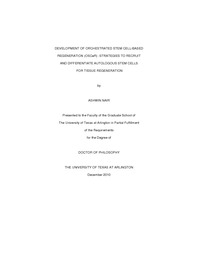
ATTENTION: The works hosted here are being migrated to a new repository that will consolidate resources, improve discoverability, and better show UTA's research impact on the global community. We will update authors as the migration progresses. Please see MavMatrix for more information.
Show simple item record
| dc.contributor.author | Nair, Ashwin | en_US |
| dc.date.accessioned | 2011-03-03T21:51:46Z | |
| dc.date.available | 2011-03-03T21:51:46Z | |
| dc.date.issued | 2011-03-03 | |
| dc.date.submitted | January 2010 | en_US |
| dc.identifier.other | DISS-10884 | en_US |
| dc.identifier.uri | http://hdl.handle.net/10106/5443 | |
| dc.description.abstract | Stem cell therapy has shown great promise in curing diseases. However, clinical application of stem cell therapy is often hindered by the lack of reliable sources and convenient methods to recover stem cells. Our laboratory has recently discovered that adult stem cells can be actively recruited via inflammatory chemokines/growth factor. My research was aimed towards the development of a new technology - "Orchestrated Stem Cell-based Regeneration" or OSCeR - to induce stem cell-mediated tissue regeneration by blending stem cell therapy and tissue engineering technology. This work has led to a series of interesting findings as listed below. Shortly after implantation, biomaterial implants are often accompanied by large numbers of mesenchymal stem cells (MSC) and hematopoietic stem cells (HSC) around the implantation sites. These spontaneously recruited multipotent stem cells could be differentiated into various lineages in vitro. Subsequent studies confirmed that there is a good relationship between the extent of inflammatory responses and stem cell recruitment. Very interestingly, by supplementing an osteogenic factor [bone morphogenetic protein-2 (BMP-2)] in scaffolds, the recruited multipotent stem cells turned into an osteogenic type and formed mineralized tissue in the subcutaneous soft tissue space. To apply OSCeR for regenerating different tissue, one of the main challenges was to establish scaffold a fabrication technique that could incorporate a variety of cytokines and growth factors. This was imperative since almost all tissue engineering scaffolds are unable to load and release proteins in an active form. Based on our preliminary work, we established a microbubble scaffold fabrication technique which can easily load and release bioactive proteins over a period of time. The scaffolds were characterized in an in vitro and in vivo setting.With the microbubble scaffold technique, we investigated the feasibility of applying OSCeR technology for bone and vascular graft regeneration. For bone application, a combination of BMP and erythropoietin prompted maximal cell infiltration and showed signs of bone formation. To regenerate vascular grafts, we used an intra-peritoneal implantation model to study the vascular tissue formation, especially endothelialization, of the inner lumen of biphasic vascular grafts - crosslinked urethane doped polyester (CUPE). Within a week of SDVG implantation, the lumen was quickly covered with endothelial progenitor cells and by week 2 there were signs of endothelial cells lining the lumen.Through these studies we were able to develop a novel OSCeR technology which turns the normally unwanted foreign body reactions into an appreciable phenomenon of in vivo tissue regeneration. The results from this work prove that, by blending stem cell therapy and tissue engineering, OSCeR technology may have a bright future in regenerative medicine. | en_US |
| dc.description.sponsorship | Tang, Liping | en_US |
| dc.language.iso | en | en_US |
| dc.publisher | Biomedical Engineering | en_US |
| dc.title | Development Of Orchestrated Stem Cell-based Regeneration (OSCeR) -strategies To Recruit And Differentiate Autologous Stem Cells For Tissue Regeneration | en_US |
| dc.type | Ph.D. | en_US |
| dc.contributor.committeeChair | Tang, Liping | en_US |
| dc.degree.department | Biomedical Engineering | en_US |
| dc.degree.discipline | Biomedical Engineering | en_US |
| dc.degree.grantor | University of Texas at Arlington | en_US |
| dc.degree.level | doctoral | en_US |
| dc.degree.name | Ph.D. | en_US |
Files in this item
- Name:
- Nair_uta_2502D_10884.pdf
- Size:
- 16.07Mb
- Format:
- PDF
This item appears in the following Collection(s)
Show simple item record


